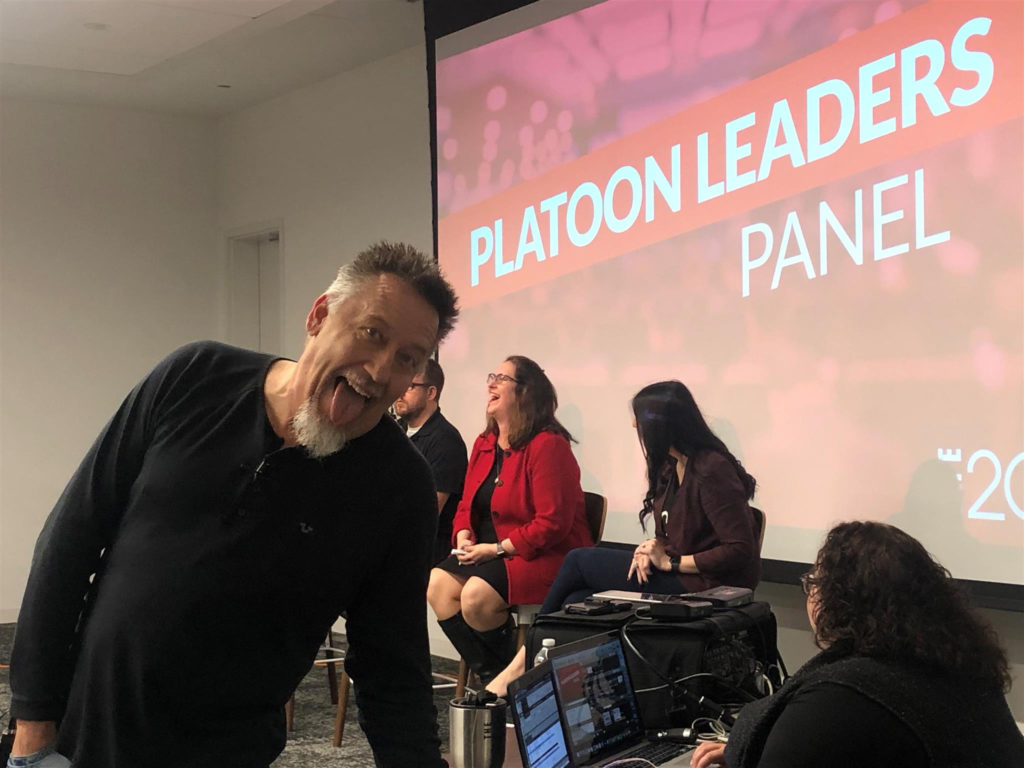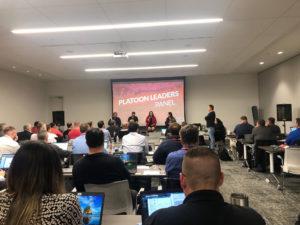Well that’s a wrap on another successful Quarterly meeting with our members!
Winter Quarterly was held at our offices at Legacy Central in Plano on January 16th and 17th, and we had an incredible time with all of you.
You’ve got to win somewhere before you can win everywhere.
– Joseph Landes of Nerdio
Our first day was entirely dedicated to in-depth training sessions by Nerdio, CloudJumper and Crayon. Each company discussed how to sell, calculate and implement Azure. The day concluded with a happy hour. It was 2 hours of games, music and good times spent with our 20 family!
Day 2 kicked off with Tim Conkle who went over with our members the best way to sell cloud and how to package it with our other software platforms. Everyone is moving more away from hardware and towards cloud.
So much was learned, and so much fun was had – there’s nothing we look forward to more than when we have our partners in town, and in the same room. It’s a tremendous energy, and we’re always sad when it ends!
If you have any questions about future Quarterly events, please contact us today to learn more about The 20! We’d love for you to be a part of our Spring Quarterly in May!
And don’t forget to sign up for our MSP Sales Academy going on next month!

Tim clowning around before start time!

Panel discussion lead by CIO Jeff Griffin, CTO Jonathan Blakey, SVP of Sales Roxann Sawyers, and COO Ciera Cole.

by Joseph Landes
Businesses of all sizes are looking to move their IT infrastructure to the cloud and the most important choice to make when doing so is finding a great IT provider who will have your best interests in mind on this journey. Promises will be made about capabilities and expertise, but it is important to keep your eye on three important things to ensure your Managed Services Provider is committed to helping you transform your IT infrastructure to the cloud.
Recommending Best in Class Products
Nothing else matters if a vendor’s product is not best-in-class and it is why so many vendors lose business in the competitive cloud ecosystem. There are too many other competitive solutions combined with somewhat low switching costs to settle for something that is not phenomenal and brings massive value to your business. When moving to the cloud, does the technology provider have a strong track record of performance? Do they have the infrastructure to scale with you as your company grows? A good sign that it is time to look elsewhere is if the product your partner is offering can’t pass a basic Proof of Concept or is just feature-poor relative to other comparable solutions. This is why I strongly recommend Microsoft Office 365 and Microsoft Azure as the core building blocks for any company’s initial foray into the cloud. No other company has invested so much into empowering businesses of all sizes to do more than Microsoft.
Adding Value to Your Business
My former CEO of Microsoft, Satya Nadella, often says that a company’s past success does not define or predict their future. That each day your partner needs to come in and continue to win your business anew. This lesson holds great relevance in the burgeoning cloud ecosystem with so many vendors, replacement options, and new technologies emerging daily. The day your partner started working with you is the day the clock started ticking on their need to constantly create value that accrues to your business. The technologies they choose must help position you as a thought leader in front of your customers. They need a clear Conditions of Satisfaction that defines their relationship with you and there needs to be regular check-ins to make sure your business is growing as result of the relationship.
Driving Down Your Cost
The cloud ecosystem is a competitive space. New technologies continue to emerge with even more powerful functionality than in months prior. Startups are being born by the hundred and thousands in the cloud and the need to maintain on-premises hardware in your office is a thing of the past. One would think that while the technology gets better, it would be more expensive to move the cloud. But it is quite the opposite! Business have increasingly been able to take advantage of economies of scale the large cloud providers like Microsoft has achieved in order to drive their costs down dramatically. In the past, a company would have to shell out many thousands of dollars to buy a server and amortize that cost over time. Now the model is consumption-based, and you only need to pay for what you use just like the electricity in your home. Moving to the cloud has a number of benefits for your business—and one significant one is driving down the cost of IT.
Moving one’s IT infrastructure to the cloud should be a near-term goal of every business. Putting off the decision to digitally transform your business could be costing you customers and making you less competitive. The time to move is now and we look forward to partnering with you on this exciting journey.
Joseph Landes is the Chief Revenue Officer of Nerdio — an exciting cloud startup in Chicago that helps Managed Service Providers build cloud practices in Microsoft Azure. Prior to joining Nerdio, he spent 23 years at Microsoft leading high-performing international sales and marketing teams and helping businesses of all sizes move to the cloud. He has travelled to 108 countries and is attempting to read every NY Times Notable Book ever published.

by Joseph Landes
As The 20 MSPs continue to evolve and build successful cloud practices in Microsoft Azure, one of the more frequent questions we receive at Nerdio is “How do I make money selling Azure?” MSPs should always be on the lookout for how Azure can improve their own business needs—namely decreased costs and higher gross profit margins. One of the best ways to do this is familiarizing yourself and deploying Azure Reserved Instances. Let’s talk about how that works.
The cost of Virtual Machines in Azure is the single biggest component of a typical MSP’s IT environment. Therefore, focusing on reducing this large consumption component is a great place to start. The savings are significant but carry a bit of complexity and need some up-front planning to take advantage of them.
Microsoft’s hyper-scale data center strategy has allowed the company to deploy many global regions at great cost to the company. As Azure adoption continues to rapidly grow, Microsoft needs to forecast demand in the various regions, which is far from trivial since public cloud is primarily advertised as a pay-as-you-go utility where you could run a VM one day and turn it off the next. To help with this forecasting challenge and to reward customers who are willing to commit to a certain amount of compute capacity in a specific region for an extended period, Microsoft introduced Reserved Instances (RIs). These RIs can save you from 20% to 57% relative to the list Pay-As-You-Go (PAYG) price.
RIs are reservations of a specific type of compute capacity (i.e., VM family/series) in a specific geographic location (i.e., Azure region) for a predefined period (12 or 36 months). Depending on the VM family, duration of the reservation, and region, these RIs can save you from 20% to 57% relative to the list Pay-As-You-Go (PAYG) price. The trade-off is that you have to pre-pay for the reservation in advance. This is great news for MSPs because typical IT workloads they deploy in Azure on behalf of their customers are persistent and customers are generally open to making one or three-year commitments.
Let’s explore how these RIs work.
When you provision a VM in Azure, two billing meters start running: base compute and Windows Server license. The published PAYG rate includes both components and every plain, vanilla VM you power on will bill you for both. RIs stop the base compute meter.
RIs are purchased with a lump sum payment via the CSP program and are applied to your tenant or subscription. Any VM running inside of that subscription that “matches” the RI will have its base compute rate zeroed out on the next invoice. Remember that RIs are purchased on a per-VM-family, per-region basis. This means that it will only match to a VM or set of VMs if they are of the same family and in the same region as the RI.
With Instance Size Flexibility, Microsoft will automatically apply any reservations in the most advantageous way to reduce the bill – if the VMs are running in the same region and have the same family as the RI. Keep in mind that RIs are a billing concept. There is nothing that needs to be done on the VM itself to stop its base compute meter and utilize the reservation. Azure does that automatically upon issuance of the invoice.
What if you need to change your reservation from one VM family to another or move your VMs to another Azure region?
No problem! RIs can be exchanged without any fees or penalties. Any unused portion of an RI will be applied as a credit towards the purchase of a new RI for a different family, in a different region, or both.
What if you need to cancel a reservation?
This is also possible, but there is a cancellation fee. The cancellation fee is 12% of your purchase price. The unused portion of your reservation will be refunded to you minus the 12% cancellation fee. There are some limitations to this on an annual basis. For example, your cancellations cannot exceed $50,000 in a year.
Let’s stop and think about this for a minute from the perspective of an MSP. The worst-case scenario is a 12% cancellation fee on a reserved instance of a VM they may no longer need in the future. However, the savings is anywhere from 20% to 57%. Therefore, cash flow considerations aside it makes sense to reserve all VMs even if they may need to be exchanged (no fee) or cancelled later (12% fee).
What if your customer cancels your managed service agreement? You have three options:
1. If you have no other customers who can make use of Azure VMs you will be forced to cancel the reservations and pay the 12% early termination fee. However, remember that your savings should more than pay for the early termination fee even in this worst-case scenario.
2. If you have other customers or are bringing in new customers who can make use of reserved Azure VMs, but who need different types of VMs or need to be in a different region, then you would exchange your reservations – at no charge – and extend them to 12 or 36 months.
3. If you have other customers or are bringing in new customers who can make use of the reserved instances in the same region and same VM family, then there is nothing else for you to do. By setting the RIs to shared scope and having all your customers under one tenant with individual subscriptions, the RIs will just keep working for you and stopping the base compute meter on VMs.
What about cashflow?
You may be concerned that having to come up with 36 or even 12 months’ worth of Azure VM fees is a burden on your company. There are financing companies specializing in working with MSPs who will finance the purchase of Reserved Instances. This way you’ll get the benefit of the RI discount but keep the cash outlay monthly. There is obviously going to be a financing fee associated with this, but with savings of up to 57% it’s still worthwhile.
In summary, RIs or reservations are a significant lever to save up to 57% of compute costs, which is the single biggest cost component of an Azure IT environment, and dramatically increase your margins. They do require some advance planning, budgeting, and structuring of your Azure account the right way, but can significantly increase the profitability of your Azure practice. On top of the inherent savings you get with reservations, you may also get anywhere from a 2%-5% discount as a CSP Direct or CSP Reseller. As you can see, discounts start to stack up and free up margin to be used in better ways.
Interested in learning more? Don’t miss Nerdio at The 20’s upcoming VISION Conference!
Joseph Landes is the Chief Revenue Officer at Nerdio—a cloud company whose mission is to enable MSPs to build successful cloud practices in Microsoft Azure. He previous worked at Microsoft for 23 years leading high performing international sales and marketing teams. When not visiting MSPs you can find him trying to visit every country in the world or reading great literary fiction.




